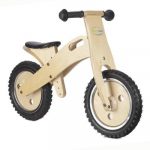Recent report from the Bicycle Industry Association reveals a prediction of an increase in kids bike sales over the past three years, signaling a substantial shift in how families approach mobility.
This trend extends beyond simple recreation, with more parents integrating bicycles into their children’s daily transportation routines for school, activities, and neighborhood travel.
Environmental concerns rank among the primary motivators for this change. This is because choosing a bike over a car just once a day reduces your carbon emissions from transportation by 67%.
Environmental benefits of children’s cycling
When examining resource consumption, the manufacturing footprint of a children’s bicycle averages 96 kg of CO2 equivalent, compared to the 5,500 kg CO2 equivalent required for producing a small family car.
Furthermore, bicycles require no fuel for operation and minimal resources for maintenance throughout their usable lifespan.
A comparative analysis of transportation methods conducted by the University of Cambridge the central London ULEZ reduced harmful nitrogen oxides by 35% and particulate matter by 15% within the first 10 months of the introduction of green zones which made the kids go to school by foot or by a bike, even though some still went by a car.
Health and developmental advantages
The physical benefits of regular cycling for children extend far beyond basic exercise. Pediatric research indicates that children who cycle regularly display superior proprioception and balance skills compared to non-cycling peers.
Regular cycling during developmental years has been linked to a 23% reduction in childhood obesity risk according to longitudinal studies.
Cognitive development also benefits substantially. Stanford University research demonstrates that children who engage in regular aerobic activities like cycling show 15-20% improvements in executive function tasks compared to sedentary counterparts.
This translates into measurable academic performance improvements, particularly in attention span and information processing capabilities.
Economic considerations for families
The financial implications of choosing bicycles as transportation solutions for children present compelling long-term benefits.
Market analysis shows that while quality children’s bicycles require initial investments ranging from £150-£400, their operational costs remain minimal compared to alternatives like public transportation or car usage. However, retailers such as Bobbin Bikes have made kids’ bikes available for as low as £120-£300.
Detailed cost modeling by transportation economists indicates that families can save approximately £1,800 over five years when using bicycles instead of cars for journeys under two miles. These savings account for purchase price, maintenance requirements, and replacement intervals for growing children.
Quality children’s bicycles also maintain remarkable value retention. Well-maintained models from reputable manufacturers typically resell at 40-60% of original purchase price after three years of use, creating established secondary markets that further reduce overall ownership costs.
Interested in this blog post? Well have a read of these...
 The Thule ProRide 598 bike carrier: A market leader?
The Thule ProRide 598 bike carrier: A market leader? Getting your child on their bike
Getting your child on their bike What Time to Choose to Travel to the UAE: From Weather to Adventure, Tips for Tourists
What Time to Choose to Travel to the UAE: From Weather to Adventure, Tips for Tourists Seasonal Pool Care: The Importance of Covering Your Pool
Seasonal Pool Care: The Importance of Covering Your Pool Jooble Recommendations on the Importance of Self-Care for Work-from-Home Fathers
Jooble Recommendations on the Importance of Self-Care for Work-from-Home Fathers

